McDonald Observatory
Fort Davis, Texas
A Jewel of West Texas
The major telescopes of McDonald Observatory sit astride two neighboring peaks in the rugged Davis Mountains of west Texas, underneath some of the darkest skies in the continental United States. McDonald Observatory has a rich history that runs both eastward through the Texas plains to the campus of the University of Texas in Austin and northward to hilly Wisconsin and two of the greatest astronomers of the middle twentieth century. Thanks to the advocacy of its charismatic directors, McDonald Observatory has also long been a leader in programs to educate the public about astronomy.
Given its remote location, more than a seven-hour car trip west from Austin and still a fair drive from the nearest landmarks (Interstate 10 to the north and Big Bend National Park to the south), a trip to McDonald Observatory requires a clear commitment.
The rolling scenery, the diverse telescope facilities, and a first-class modern visitor center make the trip worth the effort. An overnight stay in nearby small-town Fort Davis (sixteen miles away) adds to an undeniable sense of splendid isolation and a flavor of the way the western United States must have felt before the age of superhighways.
| Web site | Address |
| mcdonaldobservatory.org/visitors | HC 75, Box 1337-VC Fort Davis, TX 79734 |
| Phone (877) 984-7827 toll free |
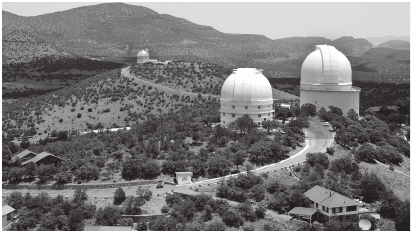
The large telescope domes of McDonald Observatory. In the top left corner, the Hobby-Eberly Telecope dome sits atop Mount Fowlkes. In the foreground, the dome of the Otto Struve Telescope sits at left and the Harlan J. Smith Telescope at right, atop Mount Locke.
McDonald Observatory is operated by the University of Texas at Austin, which manages the observatory from offices on campus, more than four hundred miles away. The observatory owes its roots to the lucky intersection of a large donation to the university by wealthy bachelor banker William J. McDonald and the desire of the University of Chicago and two leading astronomers—Otto Struve and Gerard Kuiper—to find a dark site that would improve upon their existing facilities at Yerkes Observatory in snowy southern Wisconsin.
The University of Texas and the University of Chicago combined their resources to build an 82-inch (2.1-meter) telescope on 6,791-foot Mount Locke which became the second-largest telescope in the world when dedicated in 1939. Kuiper utilized it immediately for a landmark study of the chemical composition of four hundred stars and, later, to discover small moons around planets Uranus and Neptune.
The Dutch-born and -educated Kuiper was a precocious student who trained under astronomers such as Jan Oort, for whom the vast spherical Oort cloud of distant comets that envelops our solar system is named. Kuiper then worked at Lick Observatory in California, before planning to move to an observatory on the remote island of Java. He stopped at Yerkes on his way back eastward to spend a final year at Harvard University before sailing off. Kuiper’s attitude impressed Struve, who was director of Yerkes at that time; Struve sent Kuiper a job offer that changed the course of astronomy in the Southwest from Texas to Arizona and beyond.
After amazing exploits by Kuiper in World War II that included important research in radar techniques and aiding the daring rescue of the great German physicist Max Planck, he became the second director of McDonald Observatory. Kuiper is best known today for his pioneering work in laying the groundwork for understanding both the structure and individual bodies at the outer edges of the solar system, now called Kuiper Belt objects. He went on to found the renowned Lunar and Planetary Laboratory at the University of Arizona in Tucson, which continues to be a world leader in solar system studies.
Struve, for whom the 82-inch telescope was later named, used it for his historic spectroscopic studies of stars and gas clouds in the Milky Way. A fourth-generation astronomer and veteran of the White Russian Army (the losing side in the Bolshevik Revolution), Struve was the first director of the combined observatory. By all accounts, he and his wife charmed the local populace, creating an environment in which local citizens took great pride in the presence of what must have seemed like a rather exotic group of scientists suddenly introduced into the town’s daily life.
The next large telescope built at McDonald was the 107-inch (2.7-meter) Harlan J. Smith Telescope, named for the first astronomer from the University of Texas at Austin to direct the observatory, following the expiration of the original thirty-year agreement with the University of Chicago. Completed in 1968 with crucial funding support from NASA, the Smith Telescope was the third largest in the world when dedicated. It was the first large telescope to have its pointing system be automated successfully for computer control. The primary mirror in the Smith Telescope also survived a disturbing incident wherein it was shot by a deranged employee with a gun, as a result losing a tiny fraction of its light-gathering glass surface in the process—the stuff of west Texas legend!
The dominant telescope today at McDonald, both scientifically and visually on the summit of nearby Mount Fowlkes, is the 9.2-meter (30-foot) Hobby-Eberly Telescope (HET), a bold effort to build a very large, specialized telescope for a relatively moderate cost ($13.5 million when complete). Major partners in the HET include Pennsylvania State University (home for several of its key early supporters), Stanford University, and two German universities.
Dedicated in 1997, the HET is a segmented-mirror telescope, similar to the two Keck telescopes built a few years earlier on Mauna Kea in Hawaii. Its primary mirror consists of 91 hexagonal segments that are each 1 meter (39 inches) in diameter, supported by a geometric ball- and-strut structure with more than 1,700 struts and 383 nodes, which, along with an active control system, ensures that the ensemble of mirrors forms a perfect reflecting paraboloid. This large, 80-ton structure turns on amazingly powerful air bearings. Some of the cost savings in the HET results from the fact that the HET itself does not move, but rather relies on the rotation of the Earth to move objects into its field of view. A downside is that this design both limits the effective aperture of the telescope to 9.2 meters at any one time, a loss of more than 35 percent of the maximum light-gathering power of the full 11-meter diameter of the entire mirror array, and restricts the amount of sky that the telescope can access.
The segmented-mirror approach, based partly on the technology pioneered by the two Keck telescopes, resulted in the need for an odd-looking alignment tower next to the telescope, where a laser system inside the 10-foot-diameter dome helps keep the mirrors precisely aligned with one another.
The creative design of the HET dome also helped save money: Rather than relying on dozens of steel workers and associated heavy machinery to slowly build it up, a crew of just three men used rivet guns to attach prefab aluminum sheets to a commercially purchased geodesic dome. The entire structure was then lifted in one piece by a 300-foot-tall crane and set in place in about ten minutes. The design of the HET served as the basis for the South African Large Telescope, and the approach of using segmented mirrors to make a large light-gathering surface is being applied in designs for future extremely large telescopes that will span 30 meters or more currently in development by teams in the United States, Canada, Japan, and Europe.
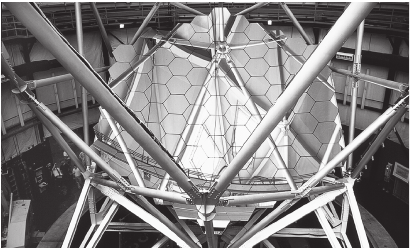
The primary mirror of the Hobby-Eberly Telescope (HET) at McDonald Observatory. The mirror is made up of 91 segments and has an effective aperture of 9.2 meters.
The HET is known primarily for its ability to produce very-high-resolution spectra of the light from both stars and distant galaxies, which makes it an excellent machine for searching for extrasolar planets and for measurements of dark energy, the subject that inspired an exciting new instrument for the telescope called HETDEX (a device that will enable measurement of the spectra of up to 10,000 galaxies during a single exposure).
Beyond the HET, the observatory also houses a laser-ranging station capable of measuring the Earth-Moon distance and the drift of Earth’s continents to better than a centimeter, as well as an automated telescope that responds to newly sighted gamma-ray bursts, powerful explosions far beyond the Milky Way.
One of the newest facilities at McDonald is a compact 1.2-meter (48-inch) robotic telescope housed in an unusual-looking clamshell dome. Called MONET, for “MOnitoring NEtwork of Telescopes” (a verbal stretch!), this project is an international partnership between McDonald Observatory, the University of Göttingen in Germany, and the South African Astronomical Observatory; a second MONET telescope will be located northeast of Cape Town. This pair of telescopes will enable searches for extrasolar planets and studies of variable stars and active galactic nuclei (AGN) and will serve as an educational tool for students in the United States, Germany, and South Africa.
For the Public
Beyond its landmark large telescopes and rich scientific history, McDonald Observatory has been a leader in astronomy education and public outreach, including popular stargazing parties, a bimonthly magazine, and (most famously) StarDate, the longest-running national radio program on science.
The centerpiece of any visit is the modern Frank N. Bash Visitor Center (named for the widely admired director of the observatory from 1989 to 2003). This graceful, low-slung building houses a 300-seat amphitheater, an exhibit hall largely centered on the science of spectroscopy, a classroom, a 90-seat orientation theater, a gourmet-style cafe, and a large gift shop. Built from distinctive red sandstone mined in Pecos, Texas, the overall geometry of the $7 million project is based on a series of three spirals—the entrance plaza, the outdoor eating area and the amphitheater—with the building situated at the center. The spirals and circles reference ancient Native American ruins found in the Southwest.
The visitor center is open daily from 10:00 A.M. to 5:30 P.M. (additional hours on star-party nights), closed only on Thanksgiving, Christmas, and New Year’s Day, with an admission fee required. Ninety-minute guided tours are offered every day at 11 A.M. and 2 P.M., along with live solar viewing via a video feed from a small telescope in an exterior building nearby, when allowed by clear skies. The HET is open for self-guided tours of its visitor galleries during daytime hours.
Twilight and evening stargazing programs are available at a moderate cost and at family rates for five or more. A combination pass can be purchased for a discount on a daytime/nighttime visit.
For a more elaborate treat, both the 82-inch and 107-inch telescopes are open on the order of once per month for private dinners and guided observing for $50 to $75 per person, making these telescopes among the largest research telescopes in the world routinely available for public use.
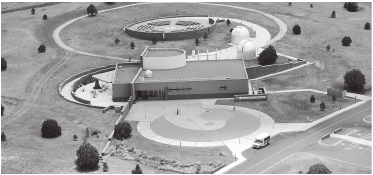
The Frank N. Bash Visitors Center opened in 2002. The interior houses exhibits, a theater, and a cafe. This photo shows the Sundial Court (front), the patio of the StarDate Cafe (left), the Rebecca Gale Telescope Park (right, rear), and the amphitheater (center, rear).
A recorded message detailing hours, prices, and other information about visiting the observatory is available at (877) 984-7827. For other inquiries, send e-mail to info@mcdonaldobservatory.org.
The observatory is also one of the few to publish its own popular-science magazine. The bimonthly StarDate (with a circulation of about 8,000) began publishing in 1986, while the ubiquitous StarDate radio program runs on 350 stations nationwide, and its Spanish-language cousin, Universo (provided free of charge, see www.radiouniverso.org), runs on about 145 stations. Call 1-800-STARDATE for more information.
For Teachers and Students
McDonald Observatory staff conduct a variety of K–12 teacher workshops on-site, primarily in the months of June and July for four days/ three nights and for shorter periods during the school year. The courses offer twenty hours or more of continuing-education credit, using inquiry-based activities aligned with state and national standards. Teachers are immersed in the environment, taking all their meals at the observatory, meeting visiting astronomers, and learning basic astronomy skills. Typical topics include the solar system, the age of the Milky Way, and light and optics. Some programs require teacher-paid fees; others are covered by foundations and grants. See www.mcdonaldobservatory.org for the latest details.
With the help of a rotating cast of college student interns, McDonald staff members consistently update a challenging public information project known as “What Are Astronomers Doing?” This interesting feature on the observatory’s Web site provides both scientific synopses of projects and personality profiles of the researchers undertaking them—a challenging task by its very nature, but well executed.
A Talk with Anita Cochran
Assistant director, McDonald Observatory
Comet scientist Anita Cochran has served McDonald Observatory for three decades in a variety of positions with increasing responsibilities for the institution and its programs. She received her undergraduate degree from Cornell University and then moved to the University of Texas at Austin as a graduate student, where she met her future husband and fellow longtime McDonald Observatory planetary astronomer, Bill Cochran. She has spent her career studying the origins of our solar system.
What are your duties at McDonald Observatory?
I run the committee that judges proposals from astronomers for telescope observing time, and then I schedule our telescopes based on the rankings. I also run the computing services for the observatory and the University of Texas astronomy department, oversee various other technical projects, and work on reports and whatever other tasks are required by the director.
When did you first join the staff and in what sort of job? What are your earliest memories of the observatory?
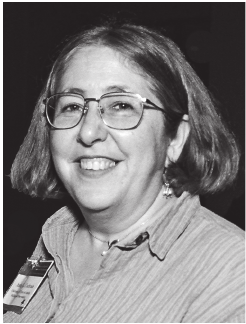
Anita Cochran, assistant director, McDonald Observatory.
I came to the University of Texas as a graduate student in 1976. I received my PhD in the fall of 1982 and joined the research staff of McDonald Observatory in January 1983. I became assistant director in January 2003.
But my first visit to McDonald Observatory came in March 1977, when I was a graduate student. I was sent out to the observatory to learn to use the 36-inch telescope to do photometry of Uranus and Neptune to determine their rotation periods. Having grown up on the Atlantic Seaboard, my first impression was that the landscape surrounding the observatory was brown and barren. I have since grown to believe it is beautiful and wonderful.
Having come out to the observatory from Austin, I was not prepared for how cold it can be on a mountain at 7,000 feet above sea level in Texas. I shivered so hard that the person teaching me to use the telescope had to tell me to stop shaking the platform. Despite that, I fell in love with observing and with watching the night sky. In March, the Milky Way stretches overhead in the middle of the night and it is quite beautiful.
How have your duties changed over the years?
Having started as a grad student, I have spent my thirty-one years at McDonald moving up in responsibility. Once I had my doctoral degree, I first became a postdoctoral student, where all I had to do was research, and someone else worried about funding. As I moved up, I had to secure funds, supervise instruments being built, etcetera. Now, I have important responsibilities in the operations of the observatory and in budget planning and personnel supervision.
My career has taken turns I never would have imagined, but helping to lead the observatory is rewarding because it helps ensure that good science is always being done. It is also encouraging to me that half or more of our current graduate students are women; it was rare to find more than a few females in my classes as a grad student.
Why study comets?
We study comets in order to understand the conditions in our solar system at the time the planets formed. I have used my observations to fit together many pieces of the puzzle of the early solar system, including helping to figure out that comets basically come from two distinct chemical reservoirs in the solar system. The fact that we see that all comets are not the same tells us that different parts of the solar system experienced different conditions when comets were formed. Since comets have changed very little since then, they offer special insights into these conditions as opposed to those we can infer from observing the planets, which have changed a great deal since they were formed (as a result of both internal and external events).
What were the most interesting times at McDonald Observatory from a scientific standpoint?
My two most exciting experiences at a telescope both had to do with comet impacts. In 1994, I was part of the team at McDonald which watched the pieces of comet Shoemaker-Levy 9 impact Jupiter. I had never imagined I would see the image of Jupiter change before my eyes! It was fantastic. Then in 2005, I was at the Keck 1 telescope watching the impact of the Deep Impact spacecraft with comet 9P/Tempel 1 and taking spectra with the HIRES spectrograph.
In contrast, when we were observing Hale-Bopp in March 1997 at McDonald, the comet was rising in the east in the morning and coming up tail first. My observing partner, Ed Barker, and I would take turns guiding the telescope and running the instrument with which we were making measurements, while the other would grab the binoculars and go running out to the catwalk to look at the comet. Ironically, it looked much better in binoculars than in a 107-inch telescope!
What would you say is the most distinctive thing about McDonald Observatory?
Because McDonald Observatory is owned and run by the University of Texas at Austin, and its observers make frequent trips to the observatory, there is a great sense of family and personal history. I have grown up, astronomically speaking, with these people. That makes it very special to me.
McDonald Observatory has incredibly dark skies because it is a long way from anywhere. It is beautiful, mountainous, semi-arid country. People who work there are highly trained but love the small-town feel. We are a high-tech oasis in the middle of ranching country.
What knowledge or understanding do you hope that a visitor would take away from a trip to McDonald Observatory?
I would hope that a visitor would take away the fact that we are searching for knowledge, and that science is about posing questions and trying to figure out what kind of data we need to collect in order to answer those questions. I also hope that a visitor would find an interest in the sky and, even once they return to their homes, they would look up at the sky and ponder what they were looking at.
How do you see the observatory evolving over the next decade or two?
Unfortunately, I see our observatory in west Texas becoming less important for forefront science as we move to bigger and bigger telescopes. McDonald will still remain an important site for doing serious work and for training the next generations of astronomers. I hope that it will also remain an important destination for the public and continue to inspire people to appreciate the night sky.
Science Highlight
The Elements of Life
The first stars that appeared early in the life of the Universe, about 14 billion years ago, were built from the mix of chemical elements synthesized during the rapid expansion of matter following the Big Bang. This chemical soup consisted primarily of hydrogen and helium—the heavier elements (those with nuclei containing larger numbers of protons and neutrons) were absent at the beginning. How did these heavier elements (carbon, nitrogen, and oxygen), which are so basic to forming the building blocks of life, and other even rarer, heavy elements come to be made?
Understanding the origin of the complete set of elements comprising the periodic table represents one of the triumphs of modern physics and astrophysics: a combination of theoretical studies, laboratory measurements, and astronomical observations working in tandem. Over the past century, we have come to learn that the heavier chemical elements are synthesized in the interiors of stars via nuclear reactions that build the heavier, more complex elements from lighter elements.
One type of nuclear reaction involves “fusion” of lighter atoms to form heavier atoms in the hot, dense interior regions of stars. The interior of the Sun is powered by a series of nuclear reactions, which in the end fuse four hydrogen atoms into a single helium atom. This is the same set of reactions that on Earth can unleash the immense power of a hydrogen bomb. Element building can also take place via “bombardment” of atoms such as iron with fast-moving lighter atoms, such as helium. Production of heavy elements via bombardment has a terrestrial counterpart in particle accelerators used for research in physics, which can produce superheavy elements by impacting uranium nuclei with a stream of lighter particles accelerated to near the speed of light.
The cosmic nuclear reactions that produce heavy elements from lighter ones can take place at a stately pace, over hundreds of millions to billions of years at the centers of stars having masses within a factor of a few times our Sun. At the other extreme, heavy elements can also form in just a few seconds when a star ten to one hundred times more massive than the Sun explodes violently, becoming a supernova.
Supernovae produce heavy elements both by rapid fusion of lighter elements and by bombardment of newly formed heavy elements by fast-moving hydrogen, helium, and other light nuclei. Element production at intermediate speeds (over several million years) can also take place via bombardment in hot, nuclear-burning “shells” below the surfaces of red giant stars (stars of mass similar to the Sun whose surface temperatures are half that of the Sun, but whose radii are thirty to one hundred times larger).
Over time, chemical elements produced in stars via a variety of nuclear reactions are expelled into the gaseous medium between stars and galaxies, enriching the initially hydrogen- and helium-dominated gas with heavier atoms. The mechanisms for expulsion range from the explosive (via supernovae, which can eject atoms at tens of thousands of kilometers per second) to the comparatively gentle (by stellar winds blowing at a few hundred kilometers per second, which carry off heavy elements transported by convective currents from stellar interiors to their outer atmospheres). Next-generation stars are formed from this heavy-element-enriched gas and, in turn, build more heavy elements, eventually ejecting these newly formed heavy elements into the interstellar or intergalactic medium. All of the chemical elements on Earth are by-products of 7 billion to 10 billion years of this grand set of processes—in supernovae, the cores of stars a few times the mass of the Sun, and in the shells of red giant stars. In a very real sense, humans and other life forms owe their existence to the buildup of chemical elements in stars, their eventual ejection into the vast gaseous medium between the stars, and their incorporation into new stars and their associated planetary systems.
Astronomers at the McDonald Observatory have played key roles in assembling the story of how chemical elements are made, in what quantity, when, and in what kinds of stars, how they are transported to stellar surfaces, and how they eventually make their way into the interstellar medium to form new generations of stars. Their main tool for exploring how the mix of chemical elements evolved over the history of our Milky Way galaxy—and indeed over the history of the Universe—is the spectrograph.
This instrument makes use of an optical element (such as a prism or grating) to disperse the light from distant stars into its component colors. A simple, small prism held up to the Sun will produce a “rainbow” of colors. A large prism or a grating, such as those comprising the basic element of a spectrograph, will break light up into finer colors—fine enough to reveal not only broad swaths of colors, but a diagnostic pattern of extremely sharp, dark lines superimposed on a smooth colored background. These spectral lines represent unique “fingerprints” produced as collections of atoms from a given element absorb photons of very particular wavelengths or colors.
By mounting a spectrograph at the focal plane of a large telescope, such as McDonald Observatory’s 2.7-meter Smith Telescope or the 9.2-meter Hobby-Eberly Telescope, it is possible to record the complex pattern of spectral lines arising from the mix of chemical elements present in the relatively cool outer atmospheres of stars. The role of the telescope is basically that of a light bucket, designed to collect light of all wavelengths from often distant, faint stars; the role of the spectrograph is to break up the light collected by the telescope into finely divided colors or wavelengths.
By measuring the wavelengths of individual spectral lines, it is possible to identify which elements are present in the atmosphere of a target star by comparison of the patterns observed in a stellar spectrum with the pattern of spectral lines cataloged by measurements of heated samples of elements in a laboratory setting. By measuring the strengths of individual lines arising from each element, it is possible to determine their abundances. The latter step requires not only measurement of line strengths, but modeling of the temperature and pressures in the atmospheres of stars. This complex process, which depends on computer simulations, finds ultimate verification in its ability to successfully match the observed pattern of line strengths for the lines of all elements.
Scientists at McDonald have carried out spectroscopic measurements of stars spanning a wide range of masses, ages, and evolutionary states. From these measurements, they are able to trace how the abundances of different elements evolve over time by comparing the abundance patterns in stars formed early in the history of the Milky Way, when heavy elements were relatively rare, with those of more recently formed stars whose chemical abundances reflect the contributions to the current “mix” resulting from the ejecta from multiple generations of stars.
By examining the chemical patterns in stars of a given mass, but captured in different evolutionary states, McDonald astronomers have begun to develop an empirical understanding of what kinds of elements are produced by stars of what mass and at what evolutionary state.
From their measurements and those of other researchers, we now have a fairly good idea of how and in what quantity elements are produced in stellar cores and shells; how and at what rate these elements are “mixed” from interior to shell, from shell to atmosphere and vice versa; and how newly formed elements are ejected into the interstellar medium. These same studies provide powerful insights not only into how elements are made, but into the structure (temperature and pressure) of the hidden interior regions of stars—crucial to improving our understanding of the basic physical processes that govern the stars’ evolution and eventual death.
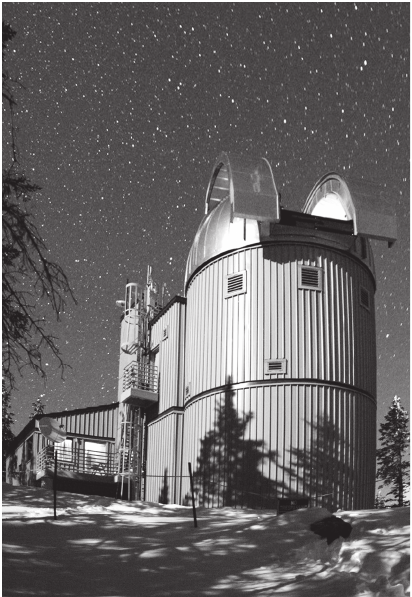
Exterior view of the Vatican Observatory Telescope at night with shutter open.